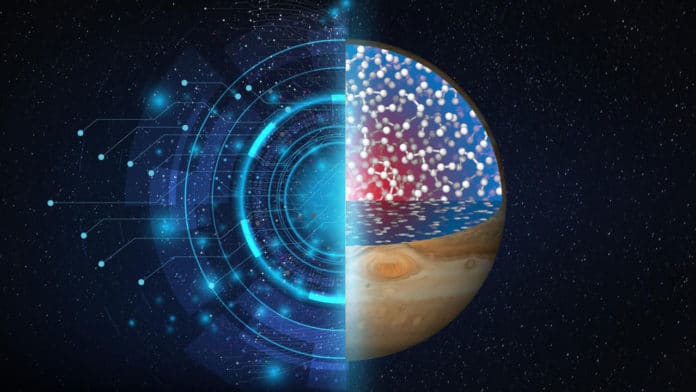Hydrogen, the simplest and most abundant element in the Universe, develops a remarkably complex behavior upon compression. Since Wigner predicted the dissociation and metallization of solid Hydrogen at megabar pressures almost a century ago, several efforts have been made to explain the many unusual properties of dense Hydrogen, including a rich and poorly understood substantial polymorphism, an anomalous melting line, and the possible transition to a superconducting state.
Professor Michele Ceriotti, heads the Laboratory of Computational Science and Modelling (COSMO) within EPFL‘s School of Engineering and colleagues from the University of Cambridge and IBM Zurich, have used computer simulations to understand the nature of this elusive transition.
Scientists used AI to make a significant breakthrough in understanding how Hydrogen behaves on Saturn and Jupiter.
Professor Ceriotti said, “Hydrogen is the simplest element on the periodic table: it’s made of one proton and one electron. That’s one reason why scientists study it so much. What makes this phenomenon on giant planets fairly unique – and interesting – is that the transition is between two forms of a liquid state, not from a liquid to a gaseous or solid-state.”
Ceriotti said, “This transition has been the focus of an intense research effort – many research groups have tried to gain a better understanding by replicating it in a laboratory. But that’s really difficult because you have to create the same conditions here on Earth as those on Saturn and Jupiter, which means achieving pressures that are around a million times greater than that of the Earth’s atmosphere and then analyzing samples that have been exposed to those pressures. As you can imagine, examining compounds under those conditions isn’t easy. Various studies have been conducted, but their findings are often controversial because they differ substantially from each other.”
Instead of recreating giant planets’ atmospheric conditions in a lab, scientists used highly precise computer models to simulate them digitally.
Past endeavors to do so included solving on the fly equations depicting the quantum mechanical behavior of fluid Hydrogen. The intricacy of such conditions restricted the extent of such simulations to only a couple of atoms one after another and the time scale to short of what one billionth of a second.
Using computer simulation and machine-learning-based models, scientists expanded the scope and time scale of their simulations and gain insight into the mechanisms at work in the hydrogen transition. That required using very powerful computers.
Ceriotti said, “It was a considerable investment in terms of time and energy. Running our models – which we developed using machine learning – took several weeks on EPFL’s supercomputers. But if we’d tried to run models developed the conventional way, it would’ve taken hundreds of millions of years.”
The outcomes explain why previous studies produced such different results, which might be traced to the interpretation of experimental observations and the liquid-liquid transition nature.
Ceriotti said, “Until now, all the studies that tried to model Hydrogen’s behavior on giant planets assumed that the transition from an insulating to a metallic form was clear-cut. But our simulations indicate that the transition takes place gradually. As a consequence, the exact moment where the transition occurs depends on the choice of criteria, and the observable being monitored – which could explain the dependence on the details of the experiments.”
“Now that we’ve modeled the ‘ideal’ system, our next step will be to study more realistic – and therefore more complex – conditions, where Hydrogen is mixed with helium and other compounds in the planets’ atmospheres.”
Journal Reference:
- Cheng, B., Mazzola, G., Pickard, C.J. et al. Evidence for supercritical behavior of high-pressure liquid Hydrogen. Nature 585, 217–220 (2020). DOI: 10.1038/s41586-020-2677-y
